Phone.com and Dialpad are voice-over-internet-protocol (VoIP) solutions offering basic telephony and video functionality for relatively cheaper pricing than leading competitors. Between Phone.com vs Dialpad, Phone.com has more flexible pricing with its all-inclusive metered and unmetered plans. Dialpad, on the other hand, offers rich artificial intelligence (AI) capabilities for automating workflows across employee and customer experiences.
Based on our comparison, the best use cases for Phone.com vs Dialpad are as follows:
- Phone.com: Best for budget-conscious businesses with fluctuating call volumes
- Dialpad: Best for tech-savvy teams needing intelligent voice capabilities for automating workflows
If you’re looking for a better alternative to Phone.com and Dialpad, consider a comprehensive VoIP solution with robust call management and app integrations:
- RingCentral: Best complete phone solution for managing high call volumes
Phone.com vs Dialpad at a Glance
Monthly Starting Price (per User) | $14.99 | $23 |
Free Trial | ✕ | 14 days |
Unlimited Calling |
| U.S. and Canada |
Unlimited Texts | U.S. only | U.S. and Canada only |
Virtual Phone Numbers |
|
|
Auto-attendant | Basic | Multi-level |
Key VoIP Features |
|
|
Video Meeting Length & Capacity | No time limits with up to 100 participants | Up to five hours with 10 attendees |
Desk Phone Support | ✓ | ✓ |
Customer Support | 24/7 via phone | 24/7 via phone and live chat |
For More Information |
Best Alternatives
While Phone.com and Dialpad are promising solutions for small businesses, they may not be the best option for specific needs. They lack robust app integrations, customer engagement features, and in-depth call analytics. Other options are available if you need extensive call management, a customer engagement platform, or simply a virtual phone service. A few Dialpad vs Phone.com alternatives include:
- RingCentral: Beyond a business phone system, this provider offers HD video meetings, in-depth analytics, and messaging in a single app. It has the largest ecosystem of integrations with over 300 third-party software, allowing you to bring advanced communication functions into the apps you use every day. Head over to our RingCentral review to learn more.
- Grasshopper: This virtual phone number provider charges a flat monthly pricing regardless of the number of users connected to its service. All-inclusive plans include SMS, custom greetings, voicemail, and call forwarding. See our Grasshopper review for more information.
- Nextiva: Nextiva unifies all communication channels in one platform to provide a seamless employee and customer experience. Manage all conversations in one place with access to team collaboration and customer engagement tools. Check out our Nextiva review for details about pricing and features.
Best for Pricing: Phone.com
Pricing is based on a monthly per-user basis. All plans include 50 call features, including auto-attendant, hold music, call handling rules, call forwarding, and call blocking. Get a 15% discount with annual billing. |
Pricing is based on a monthly per-user basis. Discounted annual billing is available. |
One of our top VoIP services for small businesses, Phone.com offers cheap monthly per-user fees, mix-and-match pricing structure, and a comprehensive feature set. Combine metered and unmetered call plans so you purchase higher-tiered plans only for users who need them. Differences in feature inclusions across plans are minimal because all the standard voice features you need are on the base tier. Volume discounts apply for over five subscribers.
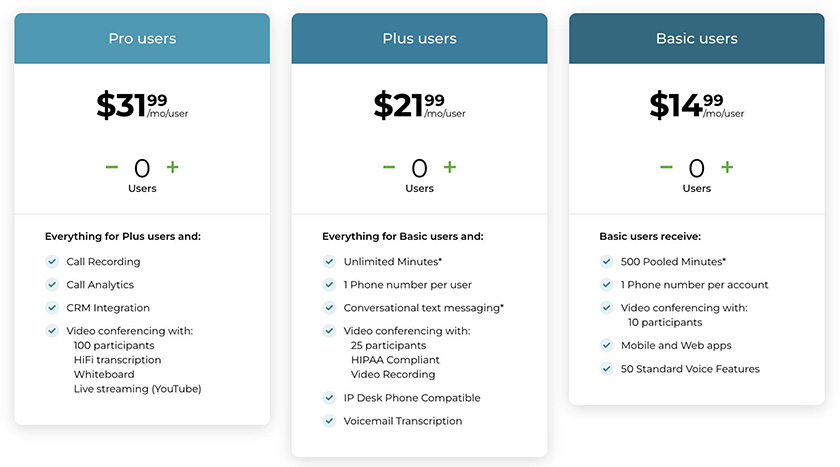
Phone.com lets you mix and match user types. (Source: Phone.com)
One standout attribute of Dialpad is its reasonable pricing for its AI-powered platform. While most providers charge higher or unlock AI features on advanced tiers, Dialpad makes all of them available at the entry-level package for a cheaper cost. However, this may be unnecessary for businesses that value extensive call management more than AI-focused tools.
Learn more about Phone.com’s mix-and-match payment model and some of its feature highlights in our Phone.com review.
Best for Call Management: Phone.com
|
|
Phone.com is the clear winner because all plans include over 50 standard VoIP features, unlike other providers that only allow complete access for higher-paying subscribers. These include auto-attendant, voicemail, call queues, and voice tagging. Core features like call routing, scheduling, and queues let you customize how and when to receive calls on specific days.
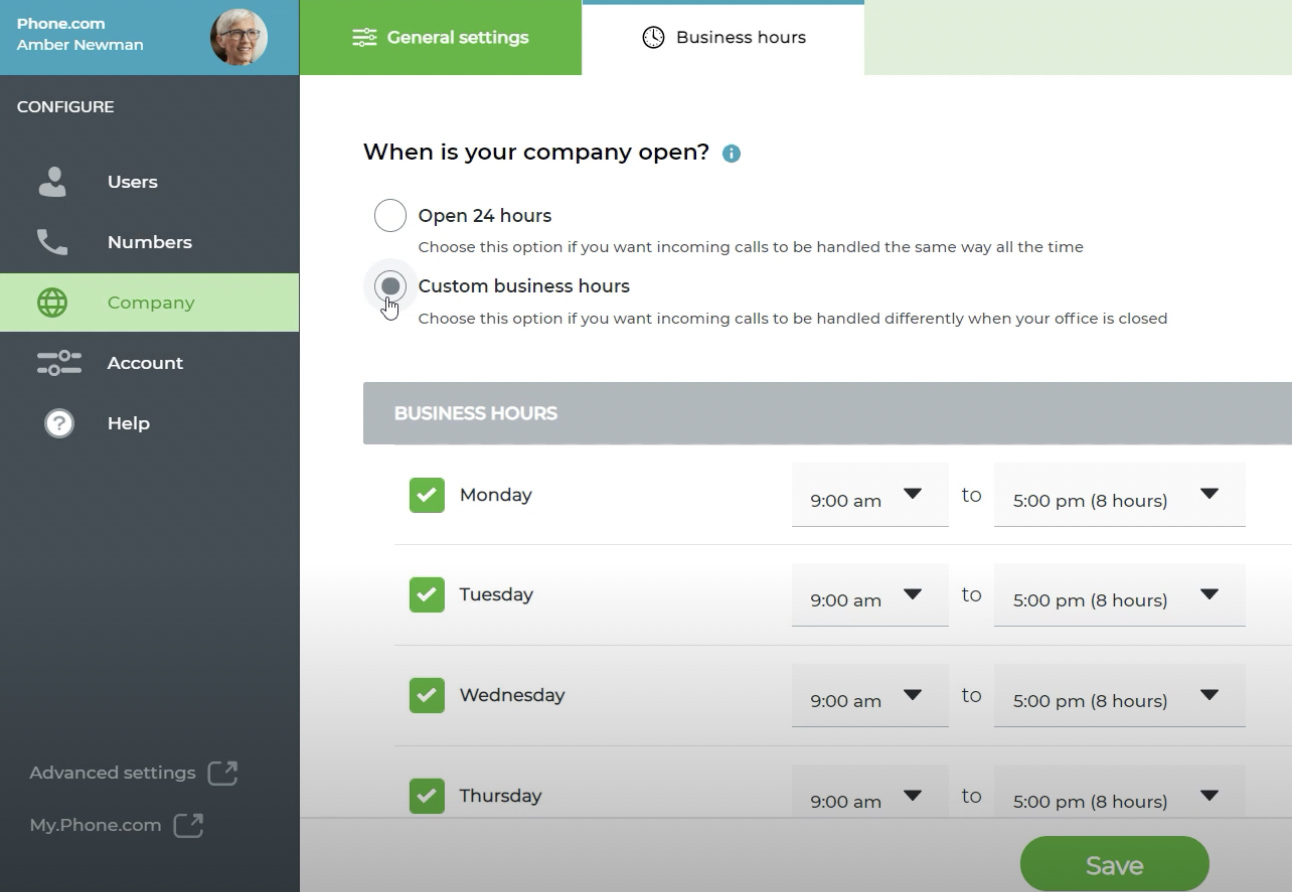
Phone.com lets you easily configure how incoming calls should be handled during and after business hours. (Source: Phone.com)
Dialpad, on the other hand, strongly emphasizes its built-in AI tools like live transcription, call summary, and sentiment analysis. However, you won’t get as many call management functions from its monthly plans. For instance, users must upgrade to the highest tier to access core VoIP features like hold queues, dial-by-extension, and unlimited ring groups.
Best for Collaboration: Dialpad
|
|
Both providers offer video conferencing on all plans, including features like in-meeting chat, screen sharing, and whiteboard. However, Dialpad adds more collaboration features like instant messaging to manage remote teams.
As a full-fledged unified communications provider, Dialpad has a workspace app with phone calls, video meetings, group chat, file sharing, and SMS/MMS in one convenient place. Create dedicated channels for any topic or project, including convenient search functionality for transcripts, contacts, messages, and shared files.
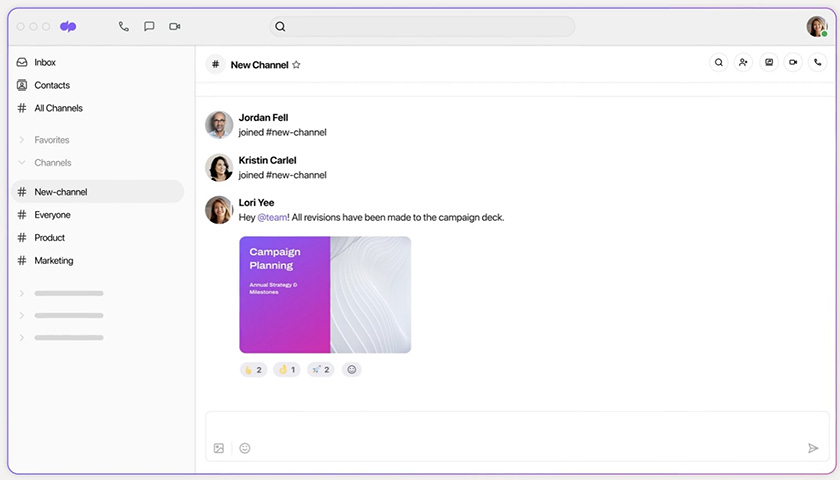
The Dialpad workspace lets you get your teams organized in channels. (Source: Dialpad)
While Phone.com’s collaboration functionality is limited to video meetings, it has a longer meeting duration and bigger participant capacity than Dialpad. On the flip side, it doesn’t offer instant messaging. Conversational text messaging is available in the Plus plan, but unlimited SMS is for one-to-one interactions only.

Phone.com provides quick access to video meeting features like screen sharing, mute, recording, and whiteboard. (Source: Phone.com)
Discover more about Dialpad’s built-in AI functionalities and collaboration features in our full Dialpad review.
Best for Global Capabilities: Phone.com
|
|
Phone.com outshines Dialpad when it comes to unlimited global calling and affordable local phone number rates. The Pro and Plus plans include unlimited calls to eight countries, including the U.S., Canada, the U.K., Italy, and France. Local rates apply if you’re subscribed to the Basic plan. Meanwhile, Dialpad only allows unlimited calls to the U.S. and Canada.
With Phone.com, global phone numbers are more affordable, starting at only $4.99 per month compared to Dialpad’s starting price of $15. However, Dialpad supports over 70 countries for local phone numbers, while Phone.com only has 35.
When comparing per-minute rates for international calling, Dialpad is noticeably cheaper than Phone.com. For example, calls to Spain and the Netherlands start at 3 cents per minute, while Phone.com charges 14 cents per minute.
Best for Integrations: Dialpad
Integrates with over 50 popular business apps, such as Google Workspace, Microsoft 365, and Salesforce. |
|
Dialpad beats Phone.com because it integrates with widely used business apps, including CRM systems and the Google Workspace suite. The Dialpad Gmail add-on enables one-click calling so you can directly launch a Dialpad call directly within Gmail. You can also access upcoming Dialpad meetings from Google Calendar. Create custom workflows for your team with Dialpad’s open application programming interfaces (APIs).

Dialpad lets you integrate your favorite apps like Microsoft 365 and Google Workspace apps. (Source: Dialpad)
Although Phone.com has integrations, the supported apps are less extensive than Dialpad’s. There are only five available applications, but you can use the Zapier integration to connect your apps for automating workflows.
Best for Ease of Use: Dialpad
Dialpad has a clean and well-organized interface, making it incredibly intuitive for new users. | Phone.com is easy to use on a web browser or desktop app but is not as intuitive as other popular VoIP providers. |
One of Dialpad’s biggest strengths is its clean, minimalist design, allowing you to easily navigate its platform without needing a demo or tutorial. From setup to configuration, everything looks user-friendly—whether you’re adding new users, updating business hours, or creating a virtual receptionist.
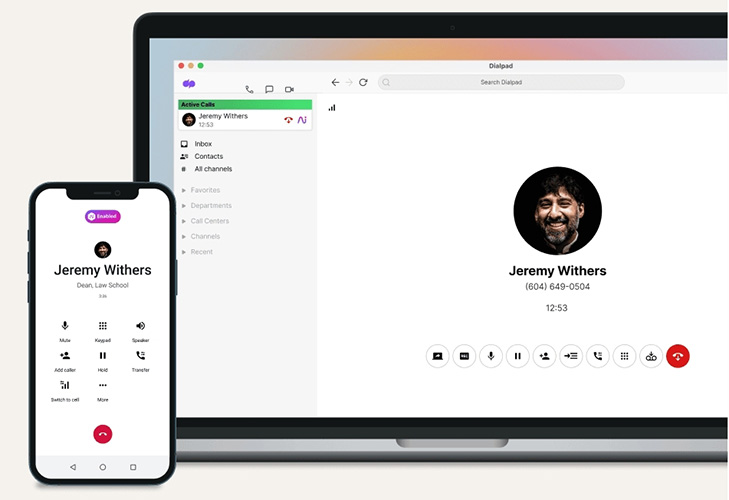
Dialpad is known for its clean and less-crowded interface. (Source: Dialpad)
Phone.com looks straightforward to use, but its overall design and layout don’t look as modern and intuitive as Dialpad or any leading VoIP competitor. Although it has a desktop app called the “Communicator,” certain functionalities are not accessible, including the ability to access the company inbox.
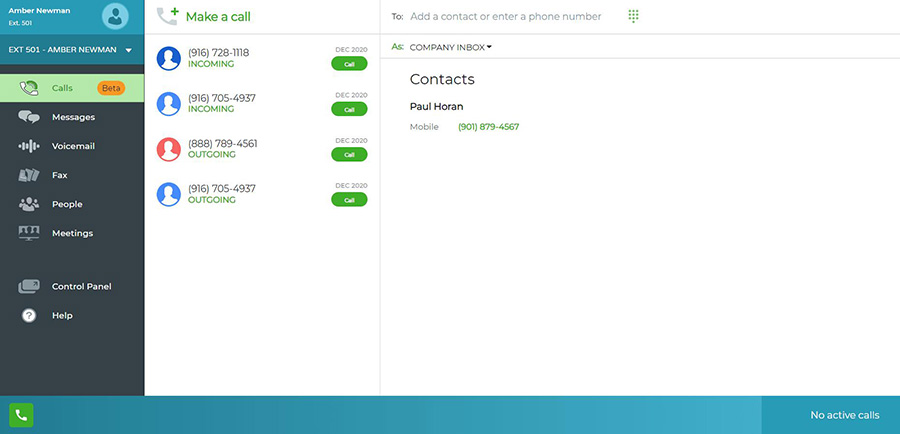
The Phone.com web browser is fairly easy to use and deploy. (Source: Phone.com)
How We Evaluated Phone.com vs Dialpad
We analyzed the business phone solutions of Phone.com and Dialpad to find out how their prices, features, and services compare. We explored their unique functionalities and considered user feedback from legitimate review websites. From there, we established a scoring system based on a set of criteria: pricing, call management, integrations, ease of use, and expert score.
Here’s a complete breakdown of these factors:
- Pricing: We compared the monthly per-user rates for Dialpad vs Phone.com to see which features unlock at each tier. We checked for a free trial and discounts for yearly billing and volume subscriptions.
- General features: We looked at the standard features essential to a VoIP service, such as an auto-attendant, call forwarding, and custom call routing. We verified which provider supports collaboration features like video meetings and instant messaging.
- Ease of use: We tested the providers’ web browser and softphone versions to determine how easy it is to configure certain features, such as setting up business hours and adding new users. In addition, we evaluated each platform based on ease of setup and navigation.
- Integrations: We checked the types of supported third-party software for each provider. We also verified if the provider allows custom integrations.
- Expert score: We analyzed the providers’ overall value by looking at their feature set, usability, and quality of customer support. We also considered user reviews to measure their popularity and determine if their personal experiences match their product expectations.
Frequently Asked Questions (FAQs)
Yes. Phone.com has a public API documentation library that lets you take control of your voice-based workflows. This lets you integrate Phone.com into your existing platforms, including billing, marketing, customer relationship manager (CRM), and support functions. Make sure to contact Phone.com’s integration experts to get started.
No. Although Phone.com’s unmetered plans include unlimited business SMS, it is only intended for conversational text messaging. You have to pay an additional fee for bulk or high-volume SMS.
Yes. Dialpad supports a variety of desk phones from leading manufacturers like Poly, Jabra, and Yealink. Easy financing options are available, such as credit card payment, billed, and lease finance.
Bottom Line
In comparing Dialpad vs Phone.com, both offer an excellent set of features for different business sizes and needs. Our evaluation ended with a tie result, with Phone.com scoring higher for pricing, call management, and global capabilities, while Dialpad earned points for collaboration, integrations, and ease of use.
Each provider is exceptional on its own based on unique use case scenarios. Dialpad is better for tech-savvy businesses needing AI-powered capabilities to streamline workflow, while Phone.com is ideal for budget-conscious businesses that want more control when choosing the best plan for their team requirements.